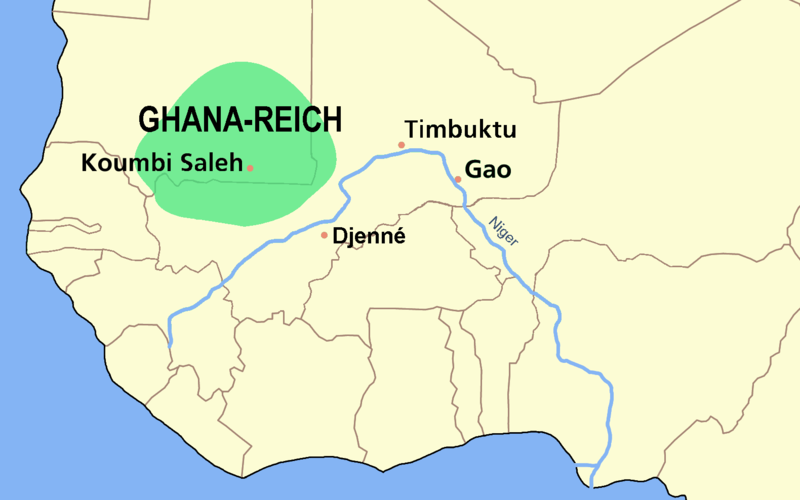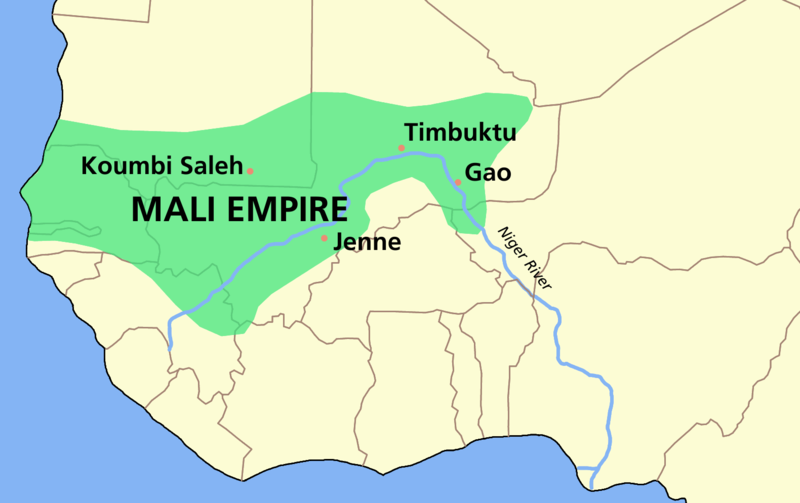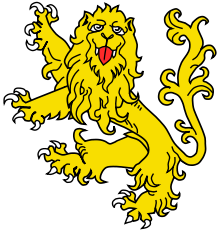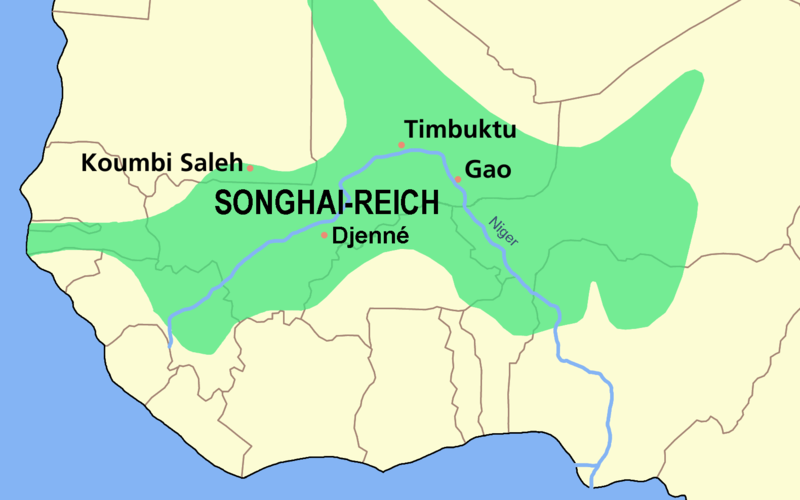West Africa and the Kingdoms in the Middle Ages
From the 7th century onwards, the majority of peoples in North and West Africa converted to the Islam. By trading with Arabic nations great wealth was achieved in the regions between the Atlantic Ocean, the Sahara desert and the river Niger. Gold, ivory and gemstones from southern Africa were traded for salt, spices, porcelain and weapons. Soon also humans became objects of trade between African and Arabic peoples, as well as the Berber people. The Arabs started human hunting and enslaved the people from the interior of the continent. Large trading empires emerged in the west and south of the continent. Between the 7th and 9th century, Princedoms developed into kingdoms in West Africa and into influential trading empires in southern Africa. In the course of Africa’s colonisation, new kingdoms originated. Some of them are still in power today.
The Ghana Empire

(c) Luxo
The Ghana Empire was not located in the same place as modern-day Ghana. It arose in the center of West Africa, between the Mauretania and Mali of today. The word Ghana simply means ‘king’. First indications of Ghana date back to around 400 AD. Still, Ghana only became the predominant prevalence between the 9th and 12th century.
How did the presumed oldest kingdom of West Africa come into being? Through camels!
Ghana’s Kings controlled the trading routes of West Africa
Only from the second century onwards, camels existed. Once they had learned how to tame the camels, more goods could be transported through the desert. At that time already, the Kings of Ghana had recognized that dominating the trading routes was very profitable.
The Conjunction of Salt and Gold Trade
The kings of Ghana were smart; they did not possess any gold, because the gold belonged to the Empires south of Ghana. They also did not own any salt. The Empires north of Ghana had salt at their disposal. But Ghana had one advantage: it was situated right in between. Ghana’s kings created a large army and controlled the trading routes. Everyone, who wanted to make use of them, had to give part of their goods as toll. The king of Ghana is believed to have commanded an army of 200 000 men to defend his trading routes. Find more about the simple life in the Ghana Empire. A travel report from the 11th century tells about the luxurious lifestyle of the kings of Ghana.
The Mali Empire

(c) Roke
The Mali Empire extended from the Atlantic Ocean to the center of the Sahelian zone. The empire’s lifeline was the river Niger. It extended on the southern end of the Sahara. Here ran a trading route transporting goods from Egypt, Nubia and from the Mediterranean Sea to West Africa. Gold from the mines in southern Africa, pelts and slaves were transported up the Niger to Gao and Timbuktu to be traded for salt, valuable fabrics and spices from the North and East. Capital cities of the empire were Koumbi Saleh, Timbuktu, Jenné and Gao.
Lion King Sundiata Keite obtains superiority in West Africa
 The Malinke people were a people of hunters, who, like most people in West Africa, had converted to the Islam. They lived on the southern border of Old Ghana. Their leaders built a princedom. Soon they came to be a big rival of Ghana. The Malinke leader was the legendary lion king Suniata Keita. He defeated the last king of Ghana in a big battle. The Malinke Empire grew to be larger and more powerful than Ghana ever was. The Malinke people seized control of the goldmines in the South and the salt mines in the North. Thus, in the 13th century, Mali developed into the wealthiest trade center in the world. The Empire extended from the Atlantic Ocean to the Aïr Mountains. Their leaders practised the Islam. Here you can read more about the heroic epic of Sundiata Keita.
The Malinke people were a people of hunters, who, like most people in West Africa, had converted to the Islam. They lived on the southern border of Old Ghana. Their leaders built a princedom. Soon they came to be a big rival of Ghana. The Malinke leader was the legendary lion king Suniata Keita. He defeated the last king of Ghana in a big battle. The Malinke Empire grew to be larger and more powerful than Ghana ever was. The Malinke people seized control of the goldmines in the South and the salt mines in the North. Thus, in the 13th century, Mali developed into the wealthiest trade center in the world. The Empire extended from the Atlantic Ocean to the Aïr Mountains. Their leaders practised the Islam. Here you can read more about the heroic epic of Sundiata Keita.
Mansa Musa, the wealthiest man of his time
Mansa Musa was the grandson of Sundiata Keita. Mansa means king of the kings. He ruled from 1312 until 1335. He was said to be the wealthiest man of his time. Mansa Musa was known beyond the borders of Africa. He probably possessed the most gold in his time. Even on today’s terms he would be richer than Bill Gates. Mansa Musa had seized control over the gold trade. He determined, that it was only allowed to trade with gold dust. He kept the gold nuggets to himself. That is why, on the picture, you can see him with a gold nugget in his hand. On his pilgrimage to Mekka he permitted so much gold to be distributed that the price for gold decreased globally. Even his subjects lived in prosperity. The slaves working in the goldmines were released after the expiry of a certain time limit. The city Timbuktu at the edge of the Sahara desert became the centre of Mali. Here, a big scholar and knowledge centre came into being.
The beginning of the Griots
With Sundiata Keita’s reign the rise of the Griots, the storytellers, began. They proclaimed the glorious victories and heroic deeds of the lion king. Ever since then do we know more about the history of West Africa. Griots were able to play several instruments; they could sing and had thousands of stories on their minds.
The Empire of the Songhai

(c) Astrokey44 CC BY SA 2.5
In the 15th century, the Songhai (pronounced song-gahy) took over prevalence over the once powerful Mali Empire. Their feared mounted warriors conquered Timbuktu and thereafter the rest of the country. The Songhai Empire was situated alongside the Niger. Gao became its new capital city. She was located at the eastern bow of the river Niger, where agriculture could still be carried out.
The Songhai’s military was so powerful that they were able to keep rivalling tribes at bay. But they were not prepared for Morocco’s rulers. Morocco wanted to win supremacy over North Africa. They had purchased firearms from European traders, through which they were able to defeat the rider’s armies of the Songhai. By the end of the 16th century, Timbuktu fell into the hands of the Moroccans. They acquired large amounts of gold, which they hauled to Marrakesh by caravans. The Songhai Empire was shattered. The conquerors placed a shadow king on the throne of the former Songhai Empire. But they were not able to rule the Empire for very long. The route across the mountains and through the desert was simply too long and weary.
The Rise of Timbuktu
Timbuktu experienced its glory days in the 15th and 16th century, after the downfall of the commercial metropolis Walata. Walata was considered to be the metropolis of caravans. Salt caravans from the North and gold caravans from the South met here. With a population of 15.000 to 25.000 inhabitants the city was fairly big for those days. Trading with salt and gold had enriched the residents. They furthermore traded with slaves and eunuchs from the Mossi land. They were meant for the dynasties in Morocco and Egypt. The downfall of Wlati began when the European naval powers built their trading bases at the West African coastline. Timbuktu became the new centre of trade at the edge of the Sahara. The traders offered metal products, weapons, horses, silk and jewellery. Apart from gold they traded with ivory, musk, cola-nuts, pepper, rubber, leather goods, as well as millet from southern West Africa. Furthermore, Timbuktu developed into the centre of Islamic spiritual life in West Africa.
As a result of the Moroccan conquest 1591, the Songhai era ended. The Sankore mosque from the 14th century is one last sign of the dramatic change of rulers. The mosque was completed in 1581, ten years before the end of the Songhai Empire.



